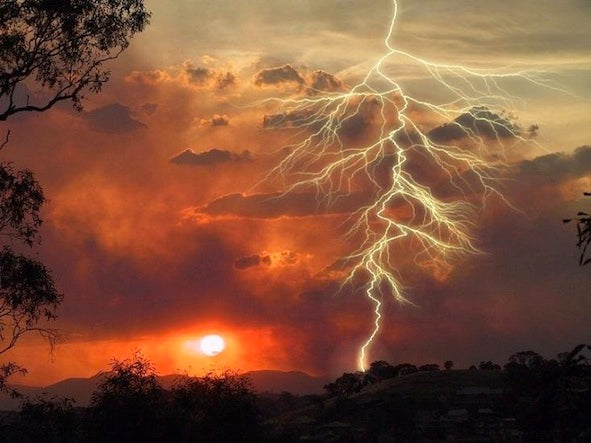
2019-2020 Victorian Fires Caused By Lightning, Not Arson, Open Data Shows
Share
The infamous fires of 2019's hottest summer in recent memory united and divided Australia.
On one hand, droves of support provided unity and much-needed relief to those desperately in need. This includes natural flora and fauna with an estimated billion animals lost and 18,636,079 hectares of bush burned.
In New South Wales, 55 national parks had more than 99% of their area affected by the fires.
Human lives were lost, civilian and firefighter alike. Reports stated 3,094 houses were destroyed across all states bar the Northern Territory, displacing entire townships and thousands of Australians.

The size of the devastation was enough to envelop most of Europe.
And yet, the rumour mill of social media indulged fanciful fables of conspiracy and arson, despite worsening climate change and a prolonged drought in the areas affected. Spurred by political influence, a hashtag tit-for-tat derailed the issue and diverted focus away from the issue.
"#ClimateEmergency" competed with "#ArsonEmergency" and Australian common sense suffered as a result. Fire authorities vehemently denied arson claims, repeatedly stating the suspect was lightning strikes. And now, The Conversation has released data that analysed the attribution of the fires.
The results are unsurprisingly logical.
The analysis suggests 82% of the fires were caused by lightning, 14% to accidents, and 1% to uncontrolled burning off leaving only 4% to acts of intentional fires.

Causes of fires from 2000-2019. Lightning is the most common cause. The number of fires is increasing, and this is mostly due to accidents. (Image via The Conversation from data by Li, 2020)
How was the data collected and analysed?
Hotspot data collected from a Japanese geostationary weather satellite, Himawari-8, covering heat source locations over time and area in close to real-time. Supplemental data was added, including temperature, moisture, rainfall, wind, sun exposure, fuel load from other sources. Distance to campsites, roads, and Country Fire Authority (CFA) stations were also included.
The Victorian Department of Environment, Land, Water and Planning (DELWP) keeps past data on bushfire ignition, ranging from 2000 to the 2018-2019 summer. By referencing historical data, the analysis can accurately predict the causes of last summer's fires with satellite data.
The DELPWP's data says 41% of fires to lightning, 17% to arson, 34% to accidents and 7% to uncontrolled burning off.
To create an accurate prediction of the 2019-2020 fires, a model was needed from the historical data. The model used a machine-learning algorithm to predict one of the four major causes mentioned earlier: lightning, accident, arson, and uncontrolled burning off.
The results were considered accurate (75%) and provided strong overall outcomes of the historical data.
The Results

Spatial distribution of causes of fires from 2000-2019, and predictions for 2019-2020 season. (Image via The Conversation from data by Li, 2020)
In total, there was a rate of 90% accuracy on lightning, 78% for accidents, and 54% for arson. The higher than expected arson percentage was mostly confused with accidents. When accounted for, the arson percentage dropped markedly to reflect the historical dataset while the accident accuracy went up.
In summary, the model used had a high percentage prediction using known historical data. And when used in the case of the 2019-2020 bushfires, the same accuracy was found. The most important factor in differentiating lightning from arson was the distance to CFA stations, roads and campsites. The second most important distinguishing factor was the average wind speed.
As common sense dictates, smaller distances to CFA stations, roads and campsites plus higher than average winds, meant the fire was the result of an accident to a high degree. Much smaller incidence of arson was found here under the same conditions.
In more remote bushfires where the bush was inaccessible to the public, lightning was accurately predicted to be the cause.
The model accurately predicted:
- 82% of fires in Victoria were the result of lightning
- Most were in dense vegetation with no road access, also reflected in the historical records
- 100% of fires in February 2020 were predicted to be caused by lightning.
- Accidental uncontrolled burning was common in March 2020 and early October 2019. Fires were already burning in March and measures were attempting to stop the spread

Spatio-temporal distribution of cause predictions for 2019-2020 season. Reassuringly, fires due to burning off primarily occurred in October, prior to fire restrictions. February fires were all predicted to be due to lightning. (Image via The Conversation from data by Li, 2020)
The use of this model means future efforts to attribute fires is accurately represented historically, and equally as important, in the media. Faster, accurate prediction combined with historical data can reduce the efforts of fire forensic teams and provide clarity for public understanding. More well-rounded fire ignition data can be used to build a complete dataset in future.
Research Credit: This analysis is based on thesis research by Monash University Honours student Weihao Li. She was supervised by the author, and former Principal Inventive Scientist at AT&T Labs Research, Emily Dodwell. The Australian Centre of Excellence for Mathematical and Statistical Frontiers supported Emily’s travel to Australia to start this project. The full analysis is available here.
#Space_Aus




